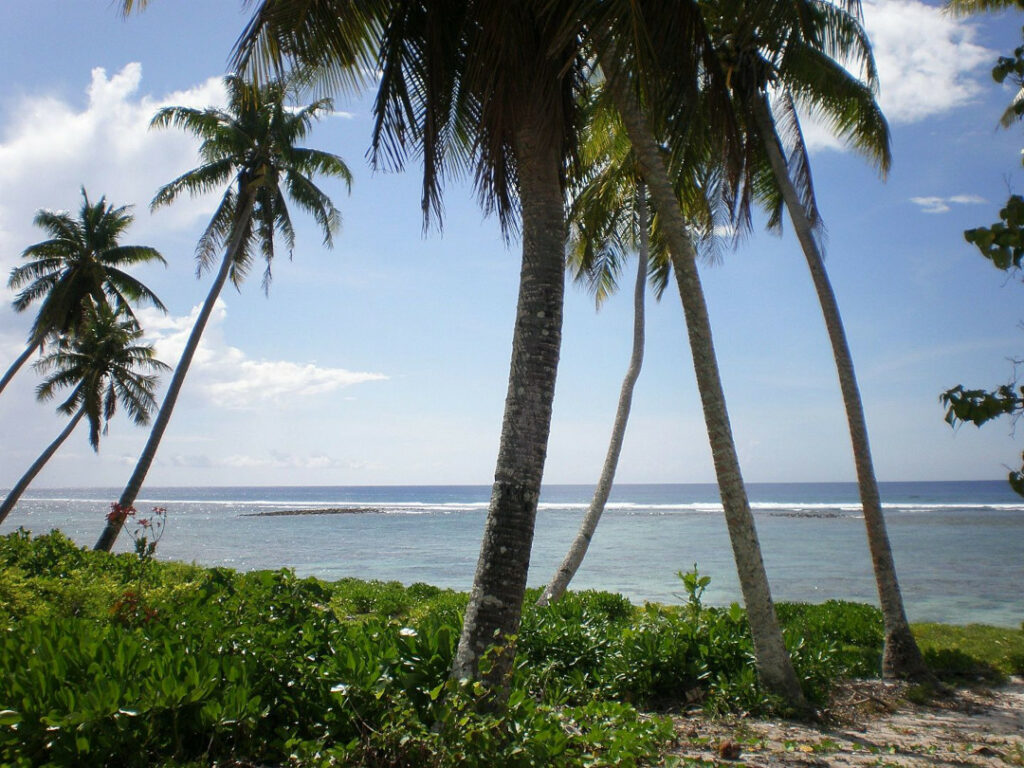
Papua New Guinea
Coconut
Cocos nucifera

General Description/Cultural Significance
Located in the southwestern Pacific Ocean, Papua New Guinea makes up the eastern half of New Guinea, the world’s second largest island. It stretches to include the Bismarck Archipelago, and many more additional islands. Papua New Guinea is saturated with an impressive diversity of animal and plant life including rainforests, mountain ranges tall enough to support cold-weather cloud forests at 3,300 feet, mangroves, over 40 species of birds-of-paradise, and a large variety of reptiles and marsupials.
The most important plant to the people of Papua New Guinea is the coconut due to its importance in so many parts of life on the islands. In many Pacific Island cultures, the coconut tree is endearingly called “the great provider.” Historically, it is the source of many vital resources for life in Papua New Guinea. The inner part of the coconut provides meat, juice, cream and oil for hair and skin; while the shell is used for decorations in cultural events, for making fires; and the leaves are woven into baskets. Even the stems are used, often as brooms. Whole coconuts have such high practical and cultural value that they are traditionally exchanged as bride prices, and given as gifts at funerals or weddings.
The coconut tree has been present in the Pacific Islands since before the arrival of the first human inhabitants, likely migrating from the tropical regions of the Americas or from the shores of the Indian Ocean. It provides a wide range of health benefits as both a food and an oil. The meat is high in fat which is not highly concentrated in many other dietary staples of the region such as plantains. Coconut water can replace water as a hydrating liquid when there is a limited supply of clean drinking water. In certain atolls where the coconut is eaten most frequently, people can eat five to six coconuts per person every day. The scent of coconut wafts from kitchens whenever traditional dishes such as Kaukau (sweet potato with coconut milk, garlic and ginger) and Mumu (taro, plantains, potatoes, and pork cooked in coconut milk) are prepared.
Climate Change/Conservation Status
Papua New Guinea is the tenth most vulnerable country in the world to climate change. The most dangerous impacts for the country come in the form of extreme weather events. The highlands are at risk for unprecedented rainfall, while the coastal regions face storm surge, rising sea levels, and flooding. Its location in the Pacific puts the country at high risk for rising sea levels, which are double the rate of the average global sea level increase. Papua New Guinea’s population is highly dispersed with 85% of the country living on subsistence farming in rural areas. This lifestyle makes them especially vulnerable to weather events with very difficult obstacles to recovery after damage to their farms, which is their sole source of income and food.
In 2021, a surge in king tides caused devastating flooding which displaced 53,000 people in Papua New Guinea. According to Human Rights Watch, The flooding was so extreme that in Bougainville, Manus Island, East Sepik, and New Ireland, the waters submerged “schools, homes, gardens, water catchments, and cemeteries, and some homes were completely washed away.”
Temperature changes in Papua New Guinea are also threatening the survival of its ecosystems. Climate change is causing temperatures to rise, but also to have a more extreme range. As a result, lower than normal temperatures in cool seasons and very intense heat in warmer seasons are impacting plant life, including the coconut tree. The environmental damage facing the people of Papua New Guinea threatens everything imaginable including their agrarian way of life, a primary source of their nutrition, the most memorable smell of their homeland, and their very survival.
Sources
Dickie, R. (2005). Indigenous Traditions and Sacred Ecology in the Pacific Islands. [online] Journal of Undergraduate Research VIII.
Human Rights Watch. (2021). Papua New Guinea’s Rapid Tides Expose Climate Risks. [online]
Jackson, R.T. and Standish, W. (2019). Papua New Guinea | Culture, History, & People. In: Encyclopedia Britannica. [online]
Malolo, M., Matenga-Smith, T. and Hughes, R. (1999). The Staples We Eat. Noumea, New Caledonia: Secretariat of the Pacific Community.
Som, P. (2021). 10 Most Popular Foods in Papua New Guinea. [online] PokPokSom.
United Nations Development Program (n.d.). Papua New Guinea | UNDP Climate Change Adaptation. [online]
World Bank (n.d.). World Bank Climate Change Knowledge Portal. [online]

